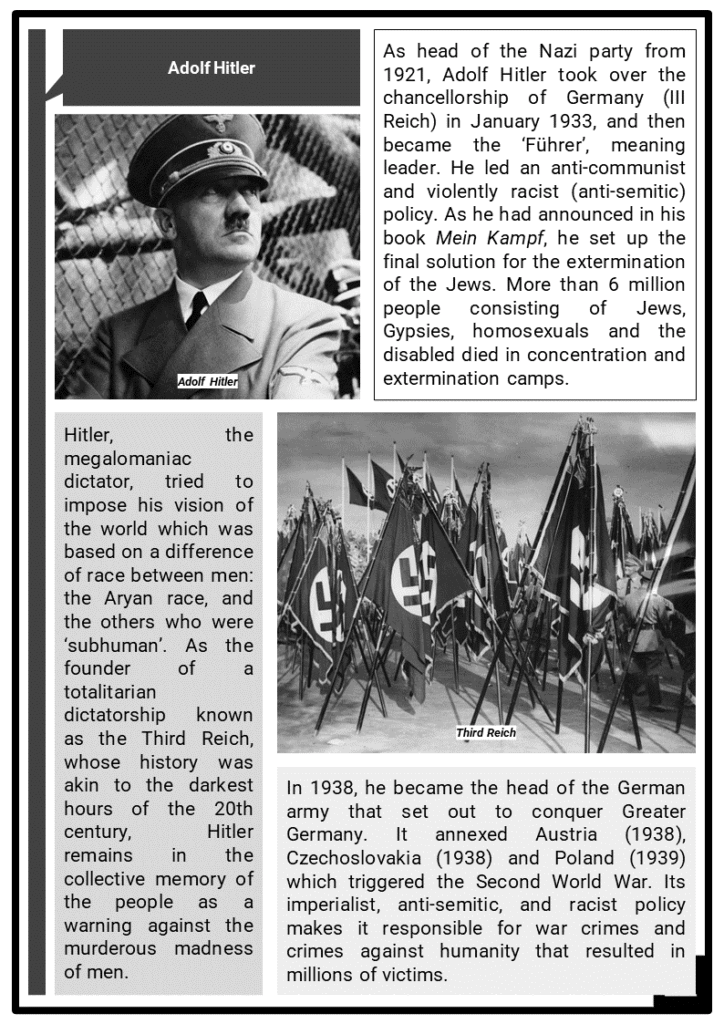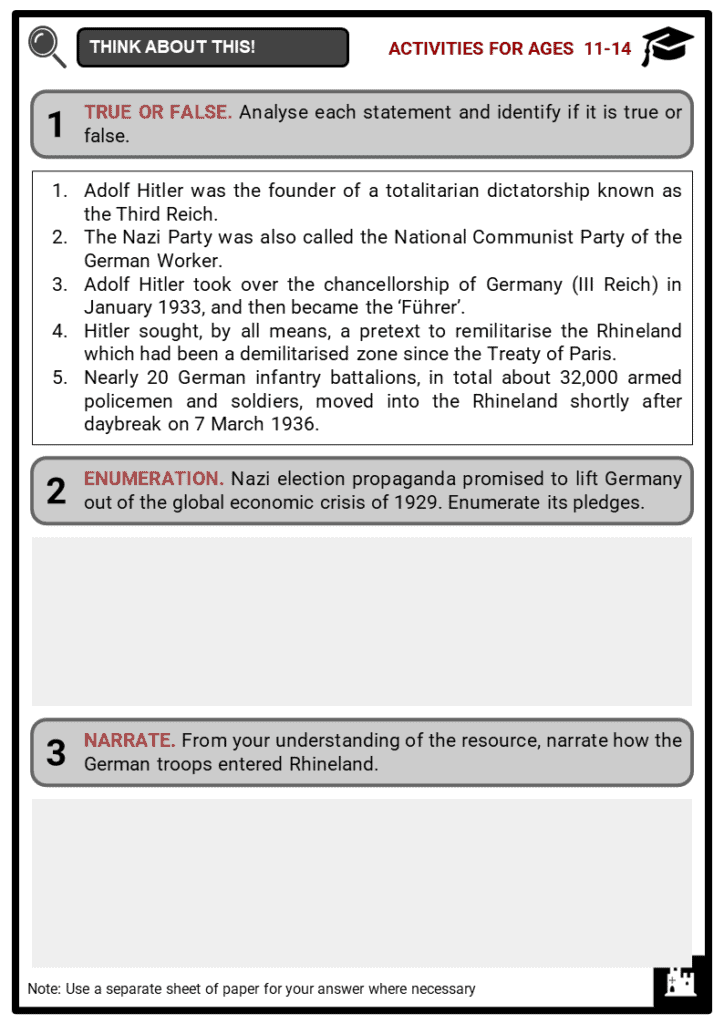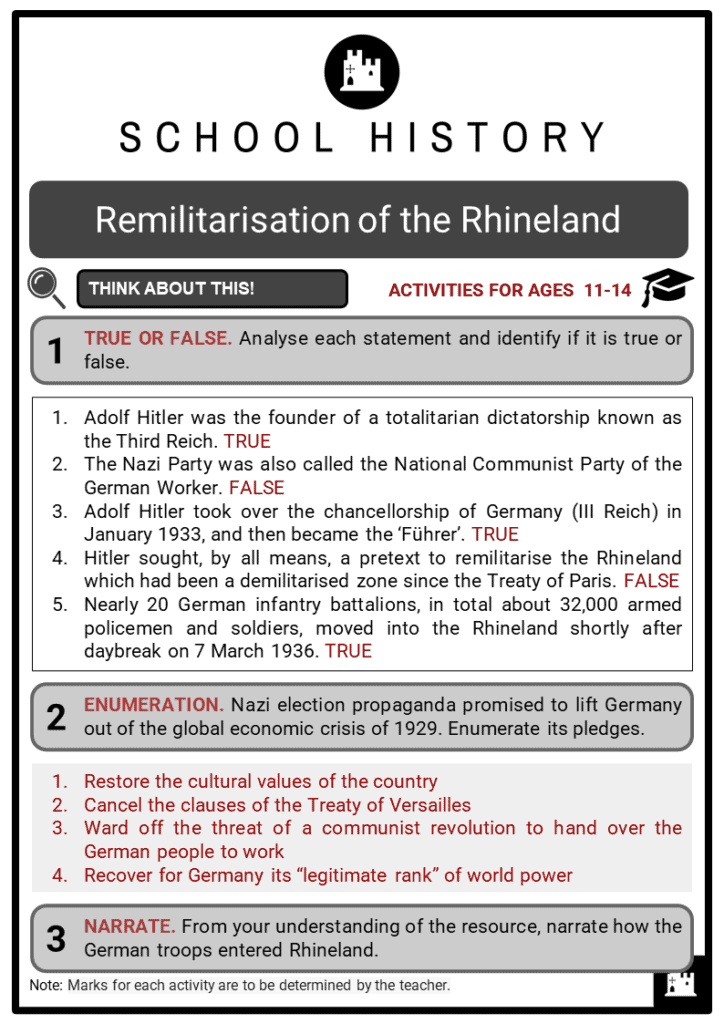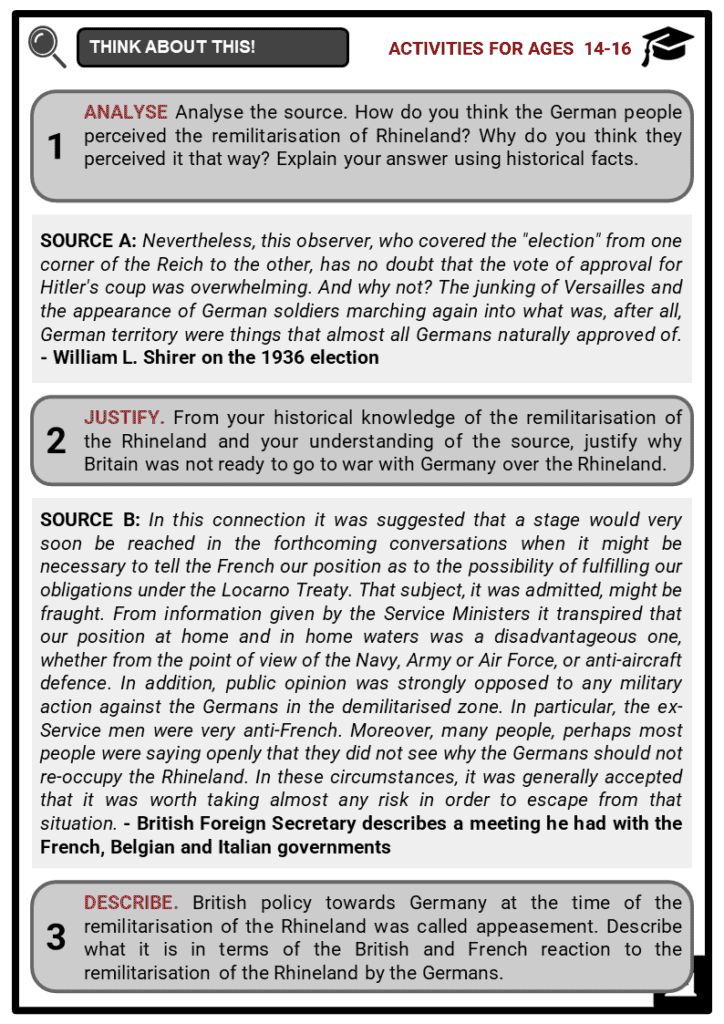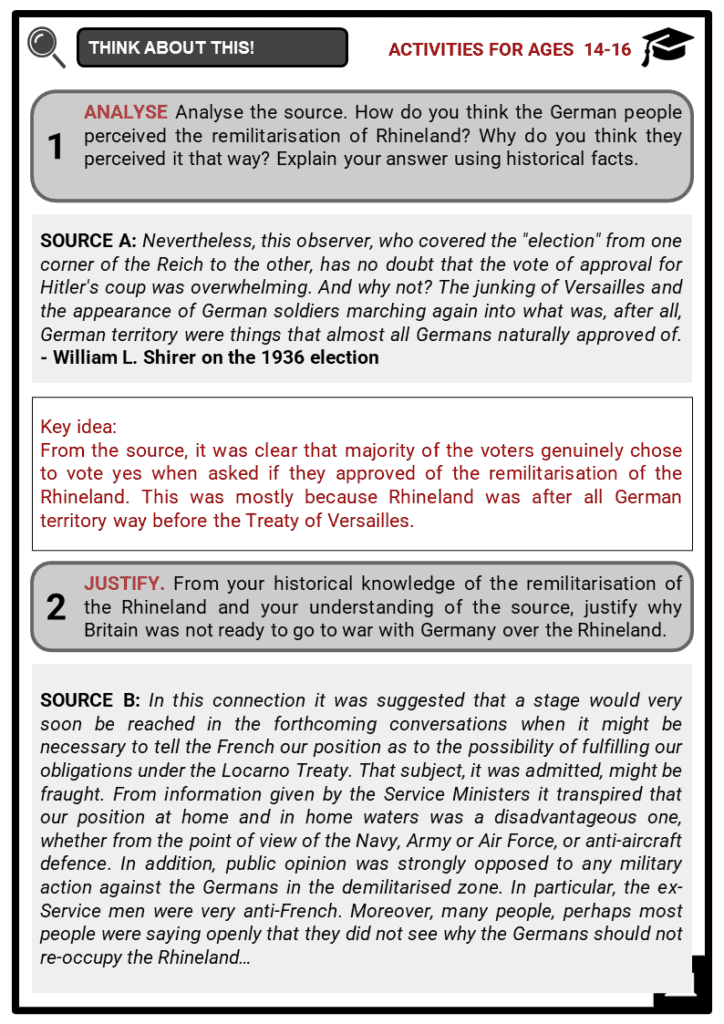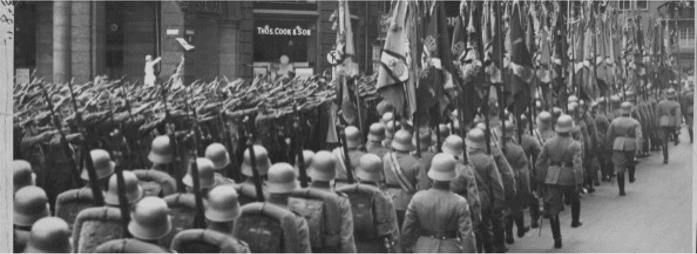Download Remilitarisation of the Rhineland Worksheets
Do you want to save dozens of hours in time? Get your evenings and weekends back? Be able to teach Remilitarisation of the Rhineland to your students?
Our worksheet bundle includes a fact file and printable worksheets and student activities. Perfect for both the classroom and homeschooling!
Table of Contents
Add a header to begin generating the table of contents
Summary
- Adolf Hitler
- The Nazis’ rise to power
- The Treaty of Versailles and the Locarno Pact
- German troops entered the Rhineland
Key Facts And Information
Let’s know more about Remilitarisation of the Rhineland!
- After the Nazis rose to power in 1933 with Adolf Hitler as Führer, Germany began working towards the remilitarisation of the Rhineland which directly contravened the Treaty of Versailles and the Locarno Pact. On 7 March 1936, nearly 20 German infantry battalions, in total about 22,000 armed policemen and soldiers, moved into the Rhineland.
- Since neither France nor Britain were prepared for a military response, they were unwilling to risk war over the issue. The remilitarisation of the Rhineland changed the balance of power in Europe from France and its allies towards Germany.
Adolf Hitler
- As head of the Nazi party from 1921, Adolf Hitler took over the chancellorship of Germany (III Reich) in January 1933, and then became the ‘Führer’, meaning leader. He led an anti-communist and violently racist (anti-semitic) policy. As he had announced in his book Mein Kampf, he set up the final solution for the extermination of the Jews. More than 6 million people consisting of Jews, Gypsies, homosexuals and the disabled died in concentration and extermination camps.
- Hitler, the megalomaniac dictator, tried to impose his vision of the world which was based on a difference of race between men: the Aryan race, and the others who were ‘subhuman’. As the founder of a totalitarian dictatorship known as the Third Reich, whose history was akin to the darkest hours of the 20th century, Hitler remains in the collective memory of the people as a warning against the murderous madness of men.
- In 1938, he became the head of the German army that set out to conquer Greater Germany. It annexed Austria (1938), Czechoslovakia (1938) and Poland (1939) which triggered the Second World War. Its imperialist, anti-semitic, and racist policy makes it responsible for war crimes and crimes against humanity that resulted in millions of victims.
- The unprecedented scale of destruction, looting and mass crimes for which Hitler is responsible, as well as the radical racism that characterised his doctrine and the exceptional inhumanity of the treatment inflicted on his victims, have earned him particular negative attention by historiography, collective memory, and popular culture in general.
The Nazis’ Rise to Power
- Before the start of the great crisis in Germany from 1929 to 1930, the National Socialist Party of German Workers (also called the Nazi Party) was only a small formation on the extreme right of the German political spectrum.
- In the Reichstag (Parliament) elections of 2 May 1928, the Nazis won only 2.6% of the votes, a relative decline from the 1924 result where they gained 3% of the votes. These elections brought to power a ‘grand coalition’ that united the Social Democratic Party, the Zentrum (Catholic Centre), the German Democratic Party, and the German People’s Party. This coalition led Weimar Germany during the first six months of the Great Depression.
- Meanwhile, on the street, the communist and Hitlerite paramilitaries began to fight each other. The Weimar Republic appeared to be responsible for all the ills of the country like the ‘Diktat’ of Versailles, war reparations, unemployment, etc.
- Hitler began to use the global economic crisis of 1929 to appeal to the millions of unemployed and poor people. As a powerful and bewitching speaker, he exploited the anger and helplessness felt by a large number of voters. He attracted a large number of Germans who are desperate for change. Nazi election propaganda promised to lift Germany out of the crisis as they pledged to:
- Restore the cultural values of the country
- Cancel the clauses of the Treaty of Versailles
- Ward off the threat of a communist revolution to hand over the German people to work
- Recover for Germany its “legitimate rank” of world power
- Hitler and the other Nazi propagandists achieved brilliant success by directing the anger and fear of the population against Jews, Marxists (communists and social democrats), and against those whom the Nazis held responsible for the signature of both the armistice of November 1918 and the establishment of a parliamentary republic. Hitler and the Nazis described them as “November criminals”.

Adolf Hitler and Rudolf Hess in Weimar, 1930 - Hitler and the other Nazi speakers cautiously adapted their speeches to each audience. For example, when they turned to businessmen, the Nazis mitigated anti-semitic themes, preferring anti-communism and the recovery of German colonies lost under the Versailles Treaty.
- In front of soldiers, veterans and other groups of nationalist obedience, the Nazi propaganda emphasized military reinforcement and the return of the other territories lost after Versailles.
- Nazi speakers pledged to farmers in Schleswig-Holstein, a region located in the north of the country, that a Nazi government would support them. In Germany as a whole, pensioners were told that the amount and the purchasing power of their monthly payments would remain stable.
- On the pretext of the impasse between the partners of the ‘grand coalition’, in July 1930 Reich Chancellor Heinrich Brüning of the Zentrum party chose the old Reich president and the marshal and hero of the First World War, Paul von Hindenburg, to dissolve the parliament and hold new elections for the month of September.
- To dissolve the House, the President applied Article 48 of the Constitution, which allowed the German government to govern without parliamentary consent, something which must be applied only in the event of an immediate national emergency. Brüning badly gauged the state of mind of the nation after six months of economic depression. The Nazis won 18.3% of the vote, becoming the second largest political party in the country.
- For two years, repeatedly using Article 48 to promulgate presidential decrees, the Brüning government sought in vain to form a parliamentary majority excluding the Social Democrats, the Communists and the Nazis. In 1932, Hindenburg dismissed Brüning in place of Chancellor Franz von Papen, a former diplomat member of the Zentrum. Von Papen proceeded to a new dissolution of the Reichstag, but in the elections of July 1932, the Nazi party won by 37.3%.
- As a result, in the Reichstag of 1932, more than half of the deputies were party representatives who had publicly pledged to end parliamentary democracy. All the traditional parties had lost votes, with the exception of the Catholic Zentrum, in favour of the extremist parties.
- Von Papen proved unable to obtain a parliamentary majority to govern, and his opponents among the advisers of President Hindenburg forced him to resign. His successor, General Kurt von Schleicher, dissolved the Reichstag once more.
- In the following elections, in November 1932, the Nazis lost ground, taking 33.1% of the votes. The Communists, on the other hand, advanced, obtaining 16.9% of the votes. At the end of 1932, President Hindenburg’s entourage came to believe that the Nazi party represented the only hope of preventing communist chaos and seizure of power. Nazi negotiators and propagandists made a powerful contribution to reinforcing this impression.
- In the following months, taking advantage of the awkwardness of the Democrats, Hitler seized all the powers with the title of Führer. In two years, however, Hitler and the Nazis swept aside the conservative politicians and set up an extremist Nazi dictatorship entirely subject to the Führer’s personal will.
- He set up a totalitarian state based on that of Mussolini, in Italy, but much more brutal, and set two evil objectives:
- To enlarge Germany at the price of annexations and conquests
- To somehow rid the country of its Jews
The Treaty of Versailles and the Locarno Pact
- Hitler sought, by all means, a pretext to remilitarise the Rhineland which had been a demilitarised zone since the Treaty of Versailles. Under the treaty, Germany was not allowed to keep troops, weapons or fortifications in the Rhineland in the west of the country. This was humiliating for the Germans as it left them vulnerable to attacks by other countries.
- Hitler considered the disarmament to be a violation of the Locarno Treaties of 1925 which were the continuation of the Treaty of Versailles that governed the agreements, collectively called ‘the stability pact’ or ‘Rhineland pact’, between the bordering countries of Germany: mainly Belgium, France, Great Britain and Italy.
- This pact was made to respect the unanimity of borders decided by the Treaty of Versailles with clauses 41 and 42 which demilitarised the Rhineland by France. The treaty stipulated that Allied forces, including American forces, would occupy this region in the event of non-compliance with these provisions. However, Hitler remilitarising the Rhineland in 1936 violated the clauses of the Treaty of Versailles and, by extension, the Locarno Treaties which ensured the sovereignty of the borders established by the Treaty of Versailles.
German Troops Enter the Rhineland
- Nearly 20 German infantry battalions, in total about 32,000 armed policemen and soldiers, moved into the Rhineland shortly after daybreak on 7 March 1936. This was the first time that the German armed forces had been in the area since the First World War. Soon after, they reached the Rhine River where German reconnaissance forces discovered that several thousand French troops had congregated very close to the Franco-German border.
- Despite outnumbering the rather small German military force, France had been experiencing a political crisis at this time; hence, there was no political leadership to focus on the remilitarisation of the Rhineland. Though the French government was horrified to find German troops at their border, they were unwilling to take action without the support of the British who argued against going to war as "Germany was only marching into its own backyard". Moreover, both Britain and France were preoccupied at the time with the Abyssinian Crisis. The remilitarisation of the Rhineland changed the balance of power in Europe from France and its allies towards Germany.
Image sources:
- http://media.iwm.org.uk/ciim5/36/803/large_000000.jpg
- https://en.wikipedia.org/wiki/Nazi_Party#/media/File:Bundesarchiv_Bild_102-10541,_Weimar,_Aufmarsch_der_Nationalsozialisten.jpg
- http://media.gettyimages.com/photos/german-troops-marching-through-the-city-of-cologne-following-the-of-picture-id467142967?k=6&m=467142967&s=594x594&w=0&h=trCZEGJhv_hg9Fom0-P13AZCi_N98zxU34vW03zxrFE=


